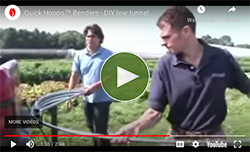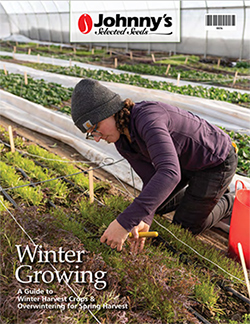- 10 Ways to Extend Your Season with Protected Cultivation
- QuickHoops Gothic High Tunnel Bender | Construction Manual for Modular Moveable Gothic High Tunnel (PDF)
- QuickHoops Gothic High Tunnel Bender | Construction Manual for Stationary Gothic High Tunnel (PDF)
- QuickHoops High Tunnel Bender | Construction Manual for Building a Stationary High Tunnel (PDF)
- QuickHoops Low Tunnel Benders | Instruction Manual (#9377 & #9520) | (PDF)
- Agribon+ AG-19, 30, 50 & 70 Row Cover | Insert (PDF)
- Hitch Mount for QuickHoops Low Tunnel Benders | Instruction Manual (PDF)
- Bobcat Automatic Ventilation Kit Manual (#6791) | Tech Sheet (PDF)
- Bobcat Pro High Tunnel Kit Manual (#6794) | Tech Sheet (PDF)
- Bobcat Pro High Tunnel Kit (#6794) | Parts List (PDF)
- Bobcat Sliding Door Kit Manual (#6792) | Tech Sheet (PDF)
- Bobcat Standard High Tunnel Kit Manual (#6795) | Tech Sheet (PDF)
- Bobcat Standard High Tunnel Kit (#6795) | Parts List (PDF)
- Bobcat Steel End Wall Kit Manual (#6793) | Tech Sheet (PDF)
- Truss Support Kit Manual (#6790) | Tech Sheet (PDF)
- Bobcat Tunnel Kits | Comparison Chart
- Beginning & Intermediate Controlled Environment Agriculture (CEA) | Advances in Greenhouse Crop Production
- 5 Cool Flowers to Plant Now | Lisa Mason Ziegler's Secrets for Growing Hardy, Cool-Season Annuals
- Hoop Loops | Installation Instructions | Tech Sheet (PDF)
- Introduction to Overwintering Flowers | Guide to Overwintering Flowers
- Overwintering Perennial Herbs
- Protect Your Crops | High & Low Tunnel Basics
- The Effect of Shorter Daylength on Winter Production
- Be First & Last to Market by Extending Your Growing Season
- Quick Hoops Low Tunnels | Set-up & Management with Eliot Coleman
- Constructing the Modular Moveable Gothic Tunnel – Animated Schematic
- Moving the Modular Moveable Gothic Tunnel – Slideshow
- Skinning the Modular Moveable Gothic High Tunnel – Slideshow
- Overwinter Flower Trials | Multiyear Results for 30+ Crops | Johnny's Selected Seeds | XLSX
- Seeding Date Calculator | Johnny's Recommended Flowers for Overwintering | XLSX
- Overwintering Onions from Seed | Johnny's Selected Seeds
- Winter Growing Guide | Part 5: Overwintering Planting Dates
- Pest & Disease Control Basics in Greenhouse, Hydroponic & Other Protected-Culture Systems
- Pests & Diseases of Greenhouses & Hydroponic Systems | Tech Sheet (PDF)
- Why & What to Grow in a Greenhouse? Basics of Protected Culture
- Recommended Varieties from Our Greenhouse Trials | What We Look for in Greenhouse Crops
- QuickHoops 3'W x 4.5'H Low Tunnel Bender (#7616) | Instruction Manual (PDF)
- Cable Purlin Trellis for QuickHoops High Tunnels | Installation Manual (PDF)
- QuickHoops Moveable High Tunnel Bender | Instruction Manual (PDF)
- QuickHoops Seedling & Microgreens Bench | Construction Guide (PDF)
- Row Cover & Insect Netting Options & Uses | Comparison Chart (PDF)
- Tufflite IV Greenhouse Film | Comparison Chart (PDF)
- Univent Automatic Opener for BiFold Doors | Instruction Manual (PDF)
- Video: Johnny's Season Extension & Overwintering Trials
- Video: Planning & Planting the Autumn Vegetable Garden | Tips & Recommendations with Niki Jabbour
- Video: Veggie Remix: Bring New Flavors & Colors Into Your Garden | Johnny's Webinar Series
- Video: Growing Under Cover with Niki Jabbour | Johnny's Webinar Series
- Video: Cover Cropping for Field & Garden with Collin Thompson | Johnny's Webinar Series
- Video: Tips & Crop Recommendations for the Autumn and Winter Cold Frame • Tutorial with Niki Jabbour
- Video: DIY Cold Frame • Easy How-to Tutorial with Niki Jabbour
- Video: How to Use Quick Hoops™ Benders to Create High & Low Tunnels
- Video: The Benefits of Row Covers | Recommendations & Tips
- Video: Hoop Houses & Other Ways to Extend Your Growing Season
- Video: Take a Tour with Us of Johnny's Greenhouses!
- Growing Under Cover with Niki Jabbour & Johnny's | Johnny's Educational Webinar Resources
- Johnny's Winter Growing Guide | Printable Brochure (PDF)
- Winter Growing Guide | Part 2: Production in the High Tunnel
- Winter Growing Guide | Part 1 - Introduction
- Winter Growing Guide | Part 3: Overwintering in Low Tunnels
- Winter Growing Guide | Part 6: Recommended Crops & Varieties
- Winter Growing Guide | Part 4: Planting Dates for a Winter Harvest
- Choosing Flower Crops to Overwinter | Guide to Overwintering Flowers
- When to Start Seeds for Overwintered Flowers | Guide to Overwintering Flowers
- Gardening in a Cold Frame With Niki Jabbour
- Webinar Slide Deck | Overwintering Flowers | 41-pp PDF
- Video: Irrigation Considerations for the Overwinter Flowers Tunnel | Johnny's Selected Seeds
- Video: Winter Sowing & Milk-Jug Greenhouses | With Niki Jabbour & Johnny's
Managing QuickHoops™
Excerpted with permission from The Winter Harvest Handbook, by Eliot Coleman
…After setting out the plants, we cover them with row cover in mid-October, the same as with the onions. Overwintered lettuce and spinach will give you outdoor crops to sell up to a month earlier than the best you can do with spring transplants. It is important to choose varieties that are hardy enough to put up with the stress of overwintering.
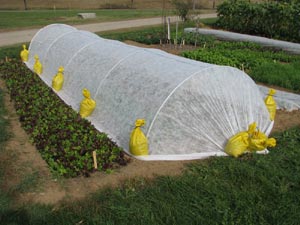
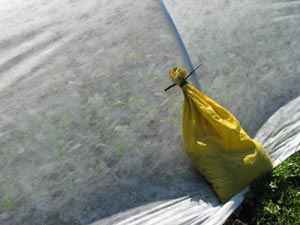
Once real winter weather threatens (late November/early December), we add a sheet of 10-foot-wide clear plastic over the row cover to make the QuickHoop tunnels more snow-proof. To stiffen the structure against wind and snow load, it's important to tighten the plastic. We do that by driving a stake into the ground 4 feet from the last hoop at each end of the low tunnel and tying a rope to each end of the plastic. We then pull as tightly as we can on both ends and secure the ropes to the stakes. That makes the plastic cover taut lengthwise. We then shift the sandbags on top of the edges of the plastic to make it taut from side to side…
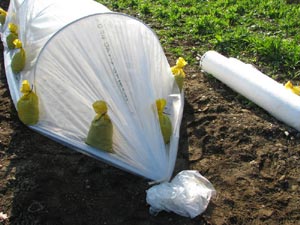
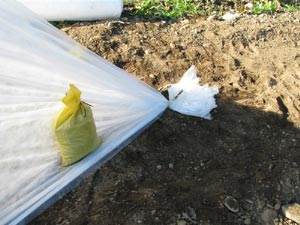
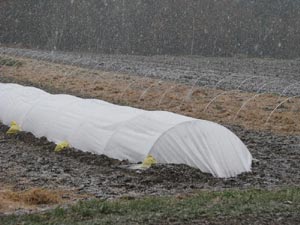
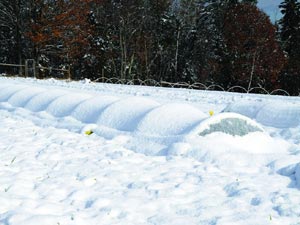
Using sandbags to secure the edges is much faster and much less work than burying the edges, although it's not as permanent. With sandbags, the covers can blow off in a really strong wind, but once winter arrives and everything freezes to the ground, nothing is going to move. The sandbags also allow us to cover every pair of beds side by side across a field because there is no need to find room to dig a trench and throw the soil aside as one needs to do when burying the edges.
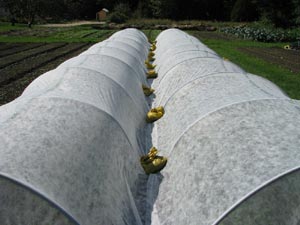
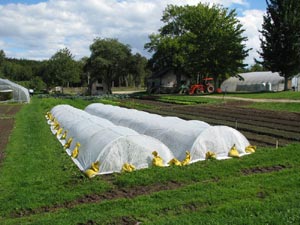
When spring arrives, we start ventilating these structures on sunny days. We remove a few sandbags along the southern edge and insert a notched prop to hold up the edges of the plastic and fabric. Once outdoor temperatures have moderated to the point where the fabric alone is protection enough (late March) we remove the plastic layers and store them until next winter….
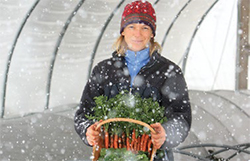
- Intro to Winter Growing
- Scheduling Guidelines for the Winter-Harvest High Tunnel
- Winter-Harvest Crops • Planting Chart
- Winter Production in the High Tunnel
- Overwintering Scheduling Guidelines
- Overwintering Crops • Planting Chart
- Protection Methods for Overwintering in Low Tunnels
- Focus on Crops & Varieties for Winter Growing
- Overwintering Onions from Seed
- Intro to Overwintering Flowers • Methods & Recommendations from Johnny's Overwinter Flower Trials


